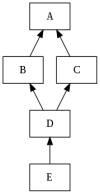In one of the books I'm using to study Python I keep seeing things like:
class Application(Frame):
super(Application, self).__init__(master):
self.grid()
self.bttn_clicks=0
self.create_widget"""which is another function in the class"""Why is the super necessary for the class if the class it's calling is itself?
